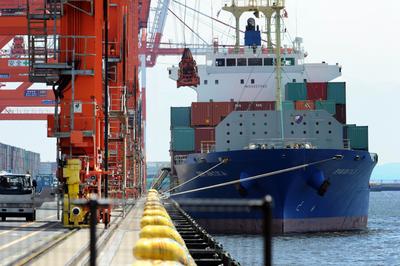But the rivalry and historical baggage no longer dominate the China–Japan relationship today. Much more important is their huge economic relationship — already the third-largest bilateral economic relationship in the world. And the scale and depth of their economic relationship is shaping their political relationship in ways that underline its cooperative, more than its conflictual, elements.
Despite the ongoing political tension, trade and commerce between Japan and China has prospered over the past 20 years or more because of both countries’ commitment to the global trading system and global trading rules. This can be seen most clearly in China’s long 15-year march toward WTO accession, where, on the way, it unilaterally lowered trade and other barriers. It showed the world, and potentially worried Japanese business, that it would work within the rules and norms of the global trading regime. Emblematically the most significant trade liberalisation by any country in recent times was the announcement of China’s unilateral trade liberalisation at the APEC Summit in Osaka in 1995.
By any reasonable measure, the institutional reforms that China signed onto when it acceded to the WTO have been implemented faithfully, and disputes with major partners have mostly been contained within the WTO system. China has credibly shown the rest of the world that it is committed to moving toward a market economy system and working within the rules set out for it.
The huge China–Japan relationship is in no way a narrowly bilateral relationship. It underpins regional growth and prosperity, and plays a driving role in East Asian economic integration and the regional production networks that have created this level of integration. The bilateral relationship is nested in a complex set of strong links (led by trade and investment) throughout the region.
Australia and other regional economic partners cannot view their relationships with Japan in isolation from their relationships with China. And Japan’s relationships with these countries are closely bound up with China. Japanese firms — once manufacturing powerhouses confined largely to Japan itself — now produce over 45 per cent of their electronics output and 33 per cent of all their manufacturing output offshore, a very large portion of that in China. Like most international brands, Sony, Panasonic and other Japanese big-name brands assemble their products in China and elsewhere in Asia, and products made in China frequently come with a Japanese name.
Australia’s business with Japan, for example, is no longer confined to Japan itself but involves three- or four-way trade in China and within the region. The strength and international competitiveness of Japan’s core manufacturing activities are inextricably bound to production systems in China and across the region. The idea that the strength of Australia’s economic relationship with Japan does not depend on the strength of Japanese–Chinese ties and Australia’s own links to China is an anachronism, a delusion that no longer reflects contemporary economic reality.
This makes it a top priority for Australia and other regional economies to keep the region open and to support the faltering global trading system, by achieving an outcome from Doha and rebuilding the WTO.
No doubt tensions will arise from time to time between Japan and China — as they must with any two powerful neighbours — and the maritime incident in 2010 was an acute reminder of how both sides, with such a big stake in regional prosperity, need to remain prudent lest they risk damaging their own interests.
Importantly, the region’s relative stability and the lessening of regional political tensions that has accompanied regional economic integration over the past few decades have been secured within the framework of global economic institutions which made these developments possible. Keeping the global system strong and open underpins the huge economic relationship that has grown between the two biggest trading partners in Asia — the second- and fourth-biggest traders in the world — and their neighbours in the regional economy.
Dr Shiro Armstrong is a Research Fellow in the Crawford School of Public Policy at the Australian National University and co-edits the East Asia Forum.
This post is part of the series on the Asian Century which feeds into the Australian government White Paper on Australia in the Asian Century.


This piece and Peter’s piece (http://www.eastasiaforum.org/2012/05/28/asias-economic-and-political-interdependence/) suggest that there is a growing recognition of the primacy of the economic, certainly in East Asia, in strategic calculations, as it indeed should be. The Westphalian model of zero-sum inter-state rivalry in the pursuit of narrowly-defined national (security) interests may have outlived its utility in an era of deepening and widening inter-economic interdependence.
Since most beneficiaries of the recent decades of development across East Asia recognise the advantage of maintaining a stable strategic milieu in which to pursue developmental goals, great-power conflict is unlikely to break out anytime soon. However, as the maritime/territorial disputes roiling the waters of the South China Sea have demonstrated, the potential for confrontations escalating to conflict is apparent and cannot be ignored without risking untoward developments. Defence white papers published in recent years by the governments of Japan, India and Australia, for instance, underscored this risk with some authority. Managing disputes in a non-zero-sum framework will demand statesmanlike visionary leadership beyond the ken of domestically focused populist politicians – a quality not evident in any abundance in the region.
Ruling elites in even the most sophisticated of societies can do with empathetic but disinterested academic advice from analysts who bring intellectual rigour to bear on analyses, especially at a time when leaderships are in transition. As this is the case in the two most powerful trans-Pacific states today, your two essays are most timely and topical.
I have benefited enormously from reading Professor Armstrong’s empirical work on the correlations between economic interdependence and diplomacy. But given current developments in Sino-Japanese relations, I wonder if he would want a “do-over” on this brief commentary. Things have gotten rather dicey since May 27th, no? Or will we, years later, look back on this moment as a hiccup?